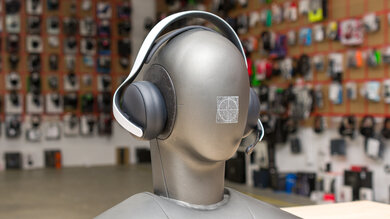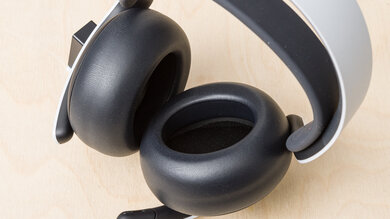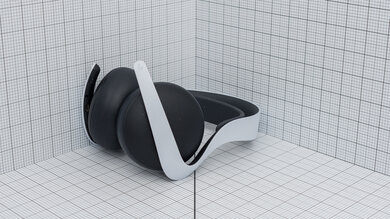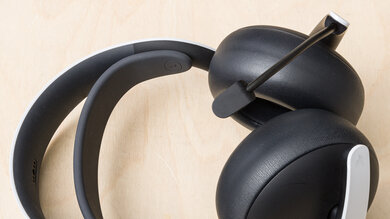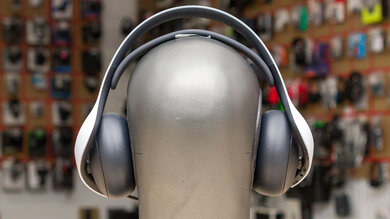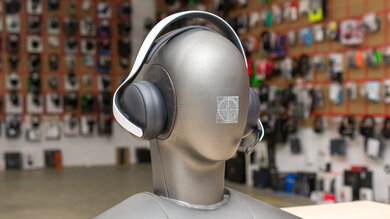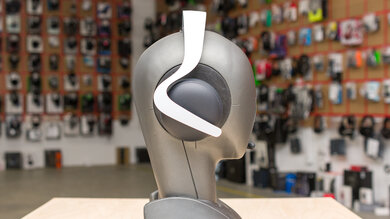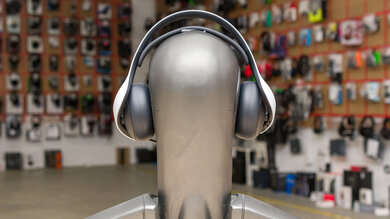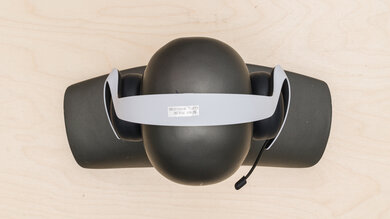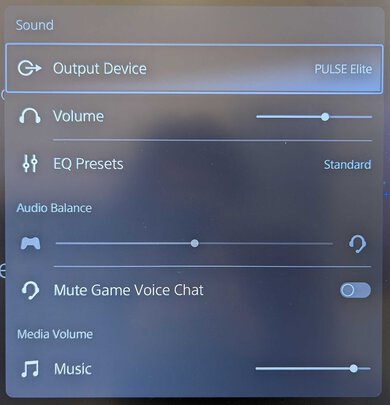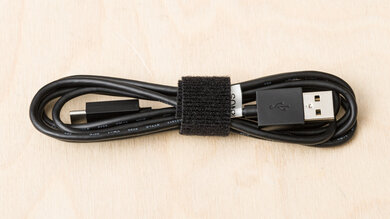The Sony PULSE Elite are Sony's first over-ear gaming headphones equipped with planar magnetic drivers, following their purchase of Audeze in 2023. They have a closed-back design, a retractable boom mic, and a nifty charging hanger. Visually, they feature an ornate, dual-headband design that wouldn't look out of place in one of the Tron movies. They're aimed primarily at PS5 users, who can adjust a range of settings via the PS5 interface, although there's support for PS4 and PC users, too. Users have reported an array of disconnection issues when connected via their dongle, though, which you can read about in the Wireless Connection (Dongle) section.
Our Verdict
The Sony PULSE Elite are passable for sports and fitness use, although they're not intended for this purpose. While they're decently comfortable and have a long continuous battery life, they're quite bulky and don't have the stability required to stay on your head during jogs. They also have some physical controls but can be finicky to use, especially on the fly. It's possible to use them via Bluetooth without bringing the transmitter around, which is a bonus.
-
Very good, 53-hour continuous battery life.
-
Clunky, unintuitive control scheme.
The Sony PULSE Elite aren't designed for use while traveling. They're decently comfortable and have a long continuous battery life, and you can use them via Bluetooth for a transmitter-free wireless experience. However, they're not very portable and provide very little attenuation against ambient noise. They'll struggle to block out conversations nearby, let alone the roar of bus engines. They also have some weak points in their construction that could be damaged on daily commutes, and their control scheme isn't formatted intuitively, so it can be difficult to input controls on the go.
-
Very good, 53-hour continuous battery life.
-
Poor noise isolation performance.
-
Clunky, unintuitive control scheme.
-
Bulky and not very well-built.
The Sony PULSE Elite are passable for office use. They're decently comfortable and don't leak much audio, which is great for quieter office settings. Their 53 hours of continuous battery life will also get you through the entire workweek without a recharge. Their main downside is disappointing noise isolation performance which means they won't block out the sound of chatty co-workers.
-
Great mic recording quality and noise handling.
-
Very good, 53-hour continuous battery life.
-
Simultaneous pairing via the transmitter and a Bluetooth device.
-
Poor noise isolation performance.
-
Clunky, unintuitive control scheme.
-
Bulky and not very well-built.
The Sony PULSE Elite are satisfactory for wireless gaming. They're decently comfortable and have a long, continuous battery life that's perfect for gaming marathons. They have a low-latency wireless performance using their dongle, while their boom mic has a very good recording quality and excellent noise handling, so you'll be crystal clear on the comms. That said, they have some caveats. Their sub-par frequency response consistency means they struggle to reproduce audio in the same way between gaming sessions, especially if you wear glasses or have a larger head. Depending on your unit, there might also be some planar crinkle present during everyday listening, which can be frustrating to deal with.
-
Great mic recording quality and noise handling.
-
Very good, 53-hour continuous battery life.
-
Simultaneous pairing via the transmitter and a Bluetooth device.
-
Graphic EQ and presets via the PS5 interface.
-
Poor noise isolation performance.
-
Tough to achieve consistent audio delivery.
-
Clunky, unintuitive control scheme.
-
Bulky and not very well-built.
The Sony PULSE Elite are decent for wired gaming. You can connect them to PCs via an analog 1/8" TRRS connection, as well as PlayStation and Xbox family consoles, for a low-latency performance. They're generally pretty comfortable, and their mic performs very well in terms of recording quality and noise handling. Their 53 hours of continuous battery life is perfect for gaming marathons, too. However, they're let down by their poor frequency response consistency and very uneven treble response. This means that, even if you can achieve a solid fit, sibilants alternate between dull and piercing.
-
Great mic recording quality and noise handling.
-
Very good, 53-hour continuous battery life.
-
Graphic EQ and presets via the PS5 interface.
-
Poor noise isolation performance.
-
Tough to achieve consistent audio delivery.
-
Clunky, unintuitive control scheme.
The Sony PlayStation PULSE Elite have middling audio reproduction accuracy. Their sound profile is generally balanced, so instruments and voices, for the most part, sound life-like. They also have a little extra bass and treble, which can make in-game effects feel more exciting. They also have bad group delay performance, meaning low-end sounds like kick drums lack punch and definition. Finally, their stereo mismatch performance could be better: our units' left and right drivers were mismatched in phase and frequency, so voices sounded incorrectly panned off-center.
The Sony PULSE Elite are bad at blocking out noise. They don't have any ANC feature, so they isolate passively but aren't able to attenuate any bass-range sounds at all. If a bus drives past your open window, you'll hear the rumbles from its engine loud and clear. They also don't block out much mid-range sound, so you'll hear any nearby conversations. Finally, they leak a lot of audio, so people around you will hear your audio, even if you're listening at moderate levels.
The Sony PULSE Elite have a great microphone system. They do a very good job recording your voice, so you sound natural and life-like, and they do an excellent job of separating your voice from any noise around you.
The Sony PULSE Elite have bad frequency response consistency. Physical features and accessories like glasses impacted the headphones' audio delivery in multiple configurations. Notably, if you wear glasses, expect a significant reduction in the bass you perceive relative to our measurements.
- 6.4 Sports And Fitness
- 5.3 Travel
- 6.0 Office Work
- 7.1 Wireless Gaming (In Development)
- 7.2 Wired Gaming (In Development)
Performance Usages
- 5.9 Audio Reproduction Accuracy
- 3.6 Noise Isolation
- 8.4 Microphone (In Development)
- 3.3 Frequency Response Consistency
Changelog
-
Updated Apr 25, 2025:
This review has been updated to Test Bench 2.0, which adds the following tests: Stereo Mismatch, Group Delay, Cumulative Spectral Decay, PRTF, Harmonic Distortion, and Electrical Aspects. We've added new performance usages and updated the text throughout the Sound tests and side-by-sides.
- Updated Apr 25, 2025: We've converted this review to Test Bench 2.0, which updates our sound tests and adds performance usages. You can read more about this in our changelog.
- Updated Sep 12, 2024: Several Sound tests have been updated following Test Bench 1.8. There have also been text changes made throughout the review, including to the product comparisons to match these results.
- Updated Sep 12, 2024: We've converted this review to Test Bench 1.8, which updates our target curve and Sound tests. You can read more about this in our changelog.
- Updated Jun 13, 2024: Based on numerous online reports, we've retested this headset to see if it disconnects during use while connected via the wireless dongle, but we couldn't replicate the issue. We've updated the text in Wireless Connection (Dongle) and Battery to reflect this.
Check Price
Differences Between Sizes And Variants
The Sony PULSE Elite come in one color variant: 'White,' which features a black inner headband and ear cups with white accents.
If you encounter another variant of these headphones, let us know in the comments, and we'll update our review.
Compared To Other Headphones
The Sony PULSE Elite are Sony's first foray into planar-equipped over-ear gaming headphones. They feature a retractable boom mic, a 53-hour continuous battery life, and a low-latency performance via their wireless transmitter. A natural comparison can be made with the planar-equipped Audeze Maxwell Wireless, especially considering Sony acquired Audeze in 2023. While the Maxwell have a higher retail price, they're much better all-around gaming headphones that deliver audio very consistently, are more comfortable, and are better built. Sony also make the Sony PULSE 3D Wireless, a cheaper alternative to the PULSE Elite. While they're also closed-back and have a similar monochromatic design, they lack a retractable boom mic, opting for an integrated one instead. As a result, their mic recording quality is worse, and the noise handling performance isn't as good. However, they deliver audio more consistently and have better build quality. If you like the idea of the Sony PULSE Elite but are put off by the reputation planar drivers have for poor quality control, consider the SteelSeries Arctis Nova 7. The SteelSeries performs very similarly to the Sony but uses more traditional dynamic drivers.
If you're looking for more alternatives, check out our list of recommendations for the best PS4 gaming headsets, the best PS5 gaming headsets, and the best gaming headsets.
The Sony PULSE 3D Wireless and the Sony PULSE Elite are both closed-back gaming headsets that share the same monochromatic aesthetic that's borrowed from the PS5. Unlike the PULSE 3D, the PULSE Elite have Bluetooth connectivity and a dedicated retractable boom mic with great recording quality and excellent noise handling. They're also more comfortable and have a longer continuous battery life. On the other hand, the PULSE 3D can deliver audio more consistently, are better built, and have a more intuitive control scheme.
The Sony INZONE H9 Wireless and the Sony PULSE Elite are closed-back gaming headphones with slightly different feature sets that will cater to different uses. While they both feature support for non-Bluetooth wireless and Bluetooth connections simultaneously, the Sony PULSE Elite Wireless can be used with a wired connection, making them a more versatile choice. The PULSE Elite are also a natural choice for users who value microphone quality, as their retractable boom mic has a great recording quality and excellent noise handling. On the other hand, the INZONE have an ANC system that helps attenuate much more ambient noise than the PULSE Elite are able to.
The Audeze Maxwell Wireless are better gaming headphones than the Sony PULSE Elite, and they're better for most uses, too. Although both use planar magnetic drivers, the Audeze are better built and have a more balanced default sound profile. They also have a more intuitive control scheme and a longer continuous battery life and feature Bluetooth multipoint connectivity. That said, both headphones are similarly comfortable and have similarly performing microphones. The Audeze retail for quite a bit more, though.
The SteelSeries Arctis Nova 7 and the Sony PULSE Elite headsets perform very similarly. They both offer warm sound, good microphone performance, and poor noise isolation. The Sony have less well-managed group delay, which may affect audio reproduction. That said, the Sony runs for about 20 hours longer off a single charge, so there's no clear winner here.
The Sony PULSE Explore Truly Wireless and the Sony PULSE Elite are both designed for gaming and are equipped with planar magnetic drivers, but the similarities end here. The PULSE Explore are in-ear buds with a more stable and portable design. They deliver audio very consistently across different gaming sessions. By contrast, the PULSE Elite struggle with audio delivery consistency. They have an over-ear design which is too bulky to be portable. On the other hand, they have an excellent microphone, and their continuous battery life is almost ten times that of the PULSE Explore. You can also use them with a wired connection, which gives them greater versatility.
Test Results
The PlayStation PULSE Elite have an uneven but balanced sound profile that generally matches our own target curve. Thankfully, a graphic EQ and presets are available via the PS5 interface, which can help tame some of these inconsistencies.
The Sony PULSE Elite have poor frequency response consistency. Audio delivery varies hugely based on various factors, including head shape, amount of hair, and whether you wear glasses or not. We conducted a large number of tests to first determine whether different connection methods caused this inconsistency. We ran passes with all three connection types, and while there were slight differences in audio delivery, they weren't significant at all.
We also ran hundreds of passes on both our testing head and a range of human heads. We found that most deviations were caused by physical factors, like head size and whether or not you wear glasses. People with larger heads heard more bass than we measured, and people who wear glasses heard much less. As a result, this headset is extremely temperamental regarding placement and fit, and even slight changes in these factors could result in noticeable bass roll-off.
The bass range target compliance is amazing. There's a bit of roll-off in the low-bass, which means explosions lack some rumble and cinematic sequences feel less intense and captivating. That said, a bump in the mid-bass compensates for this somewhat, ensuring that bass frequency sounds are still punchy and exciting. Finally, a small bump in the high-bass means instruments like bass guitars feel warm, and effects like footsteps are clearly audible.
However, it's worth noting that our results represent an average response based on multiple passes due to the inconsistency in how these headphones deliver audio, so your experience may vary.
The mid-range target compliance is great. The response is generally balanced across the entire range, resulting in mostly accurate reproduction of vocals, speech, and lead instruments. A small dip in the low-mids means busy cut scenes don't feel too cluttered. The mid-mids are mostly flat, but a dip in the high-mids means voices sound a little weak and distant. However, when playing games like The Witcher 3, dialogue is still understandable and easy to follow when receiving quests.
The treble compliance is adequate, with some significant deviations in the response across the entire range. The low treble is slightly recessed, meaning voices lack detail. On the other hand, a couple of peaks in the mid-treble add excessive brightness to metallic sounds, like cymbals or the clink of swords sparring. This can make loud battle scenes fatiguing to listen to for extended periods, but some people might find the added presence exciting.
It's worth noting that our results represent an average response based on a few passes due to the inconsistency in how these headphones deliver audio, so your mileage may vary.
The peaks and dips performance is okay, meaning these headphones deviate a fair amount from their sound profile. The bass response is a little uneven. A significant peak in the mid-bass can make soundtracks seem overly boomy and a touch bloated. The mid-range is generally well-balanced, apart from a dip in the high-mids that robs dialogue of clarity. The treble range is particularly uneven, with peaks and dips across the low- and mid-treble ranges making vocals alternately dull or harsh depending on their pitch.
These headphones have disappointing stereo matching performance with significant flaws worth noting. Our unit's L/R drivers demonstrate mismatches in amplitude across the entire frequency spectrum, with some large deviations in the high-mids that can make voices sound inappropriately panned off center. Similarly, we measured large phase deviations across the entire spectrum, meaning kick drums and higher-pitched sounds like percussion can lose precision. These issues persist regardless of input type.
The Sony PULSE Elite have bad group delay performance, particularly in the bass region. Kick drums sound loose and flabby, and basslines lack punch.
The PlayStation PULSE Elite's PRTF measurements indicate a reasonable amount of interaction between your pinna and your audio. They lack the qualities of an angled reference speaker but do offer an okay sense of sound localization and stereo space, especially considering their closed-back design.
These headphones have excellent harmonic distortion performance. They reproduce everything from low-bass to high-treble frequencies cleanly.
These headphones don't work passively; they only work when switched on.
The Sony PULSE Elite is compatible with Sony's Tempest 3D AudioTech—this feature is available natively with the PS5. Integration will vary from game to game, and some PS4 games are even supported. This feature can create a more immersive gaming experience by using a virtual soundstage.
These are the settings used to test the Sony PULSE Elite Headset. Our results are only valid in this configuration.
The Sony PULSE Elite share a similar look to the Sony PULSE 3D Wireless, drawing from the same visual cues as the PS5 consoles. They have a striking design, with black ear cups and a black padded adjustable inner headband. It's accented by a white, Möbius strip-like outer band that wraps over and around the rest of the structure. You can adjust the fit using the ski-band design. It's only available in the monochromatic 'White' colorway.
These headphones are decently comfortable. The padding on the ear cup feels supple and pleasant, and the headset overall feels flexible. Their frame is relatively lightweight and doesn't clamp your head with too much force. While they're very comfortable to wear while sitting down with your head stationary, moving your head too much or walking around causes a loud rattling sound that could be mistaken for faulty drivers.
The control scheme is disappointing. There's a limited number of buttons that have multiple functions, so inputting basic controls (like powering the headphones on) can be ponderous and time-consuming. The buttons themselves are small, easy to miss, and don't provide a great deal of tactile feedback to indicate if commands have been registered. Many of the functions you'd expect to have physical controls can only be adjusted via the PS5 interface, like channel mixing, talk-through, and mic gain. Also, when paired to a Bluetooth device, the volume function on the headphones is disabled and defaults to the volume level on your device. Fortunately, there's audio feedback in the form of a tone that sounds when you input a command. The mic mute and link buttons also have an LED indicator to show their status.
PlayStation Link Button (found on the right ear cup):
Mic mute button (found on the mic):
Volume up/down buttons (found on the right ear cup):
These headphones aren't very portable. The frame is bulky, and their unique design means they take up quite a bit of space in a bag. Fortunately, if you want to pair them with a Bluetooth device on the go, you won't need to lug the transmitter around.
While these headphones don't come with a case to help transport them, they do come with a charging hanger that you can use both to charge the headphones and keep them off potentially dusty surfaces. You can see what this looks like here.
The PlayStation PULSE Elite's build quality is mediocre. The frame and yokes are constructed entirely of plastic, with a silicone inner headband and ear cups covered entirely in faux leather. Overall, the quality of the construction is okay, although there are some obvious weak points. Both the pivots and hinges are made of weak plastic. The yokes also make a scraping noise when they collide with the main body, which can be unpleasant to hear. Despite these weaknesses in their construction, none of the parts are replaceable. The USB-A to USB-C cable that comes with the headset is made of a soft yet stiff plastic. There's no IP rating for protection against water or dust, although this is common for gaming headphones.
The Sony PULSE Elite's full-range noise isolation performance is poor. These headphones don't have any ANC feature, so they isolate passively. That said, they provide no isolation in the bass range. Unusually, our results found that they accentuate bass range noise. We compared our results with another headset to see if there was an issue with our setup. However, this second headset performed normally. We also subjectively evaluated the PULSE Elite's performance and found that, when playing bass-heavy music next door, basslines and kicks sounded louder and more muddy across the entire range. As a result, sounds like construction work outside your window will be audible and even slightly amplified. We're unsure what's causing these strange results, but we're looking into it.
They also provide almost no isolation in the mid-range, so you can hear conversations around you. They're a little better at shielding you from high-frequency noises, like fridge hum, although the level of attenuation is still quite low.
These headphones have difficulty isolating you from common scenarios. Everything that's going on around you will make its way into your audio, and bass-range sounds like the rumble of passing bus engines will even sound slightly louder with these headphones on.
Just like in our full-range tests, we found that these headphones accentuate the response of bass frequency sounds. We're currently looking into these results.
The Sony PULSE Elite have middling leakage performance. Escaping audio is mostly concentrated in the treble and midrange, and while it sounds fairly bright, it's also rather comprehensive. You can hear lead instruments, vocals, and percussion well at ambient office volumes, while bright frequencies are loud enough to interrupt nearby conversations. How audible your leaked audio is relies on variables like how loud you set the volume.
These headphones feature a flexible, retractable boom mic that you can bend to accommodate different angles.
The boom mic's recording quality is very good. Your voice sounds relatively natural and will be easily understood by whoever's on the other end.
The boom mic's noise handling performance is amazing. It does a fantastic job of separating your voice from moderately noisy environments, so if you're gaming with a fan on in the summer, your voice will still come through loud and clear. Even at higher levels of background noise, it does an excellent job of ensuring your voice is still clear and understandable, even if some noise can still be heard.
The Sony PULSE Elite have a very good battery life performance. The manufacturer advertises 30 hours of continuous battery life, but we measured 53 hours of playtime while using the dongle. Sony possibly tested these headphones using their Bluetooth connection or both connection types simultaneously, which would explain our differing results. As always, battery life will vary depending on your usage. They also have a quick charge feature that gives you two hours of battery life from a ten-minute charge. You can charge them using the included headphone hanger. They switch into sleep mode automatically after 90 seconds to conserve the battery. However, we noticed this would often disconnect the headset if connected via the dongle, so you'll need to reconnect the headset using the 'PS Link' button after.
The Sony PULSE Elite use the PS5's interface as a companion app, where you can adjust a variety of settings. You can also connect them to a PS4, but you won't have access to certain features like the 5-band graphic EQ, custom EQ presets, and control over the headphone and mic volumes. While there's no support for Dolby surround sound formats, you can enable the Tempest 3D audio feature on your PS5 and adjust the settings to create a more immersive gaming experience.
You can use the PlayStation PULSE Elite headset with a 1/8" TRRS cable, although it isn't included. Latency is extremely low when using this connection type, so you don't need to worry about audiovisual lag. They also come with a USB-A to USB-C cable for charging.
The PlayStation PULSE Elite have an okay Bluetooth performance. There's no multi-device pairing via Bluetooth, though you can connect another device via the dongle while keeping a Bluetooth device paired. They have high latency when using a Bluetooth connection, though, so if you use them to watch videos, you'll notice some lip-sync issues. It's unlikely to be a factor for gaming use, though, as you'll want to use the dongle to connect your PlayStation.
The Sony PULSE Elite have excellent connectivity via the included wireless dongle. Latency is very low when using this connection method, so you won't experience any lag between your audio and visuals when gaming. That said, the wireless connection becomes spotty at around 30m (98.4ft) and cuts out entirely at 32 m (105ft), which is quite a short range compared to other gaming headsets. However, this won't be an issue if you're gaming at home and are close to your console.
It's worth noting that many users online have experienced issues with this headset randomly disconnecting while using the wireless dongle. If you've experienced issues like this, please let us know in the forums. While we didn't experience any connection issues during the testing process, this issue does seem widespread, and you can see some of the user reports on reddit as well as YouTube. We did notice that the headset would sometimes not re-connect after automatically turning off after 90 seconds of inactivity and needed to be manually re-linked via the 'PS LINK' button.
These headphones are fully compatible with PCs via a wireless dongle or an analog connection. As you can use them wired via a 1/8" TRRS cable, you can even send audio to communicate with teammates. If your PC supports Bluetooth, you can connect to it this way, though latency will be noticeably higher.
These headphones are optimized for PlayStation family consoles, so you can connect them to both PS4s and PS5s via the wireless dongle, analog connection, or even Bluetooth for full audio and microphone support. However, you can only access features like the graphic EQ, EQ presets, and mic/headphone volume if you have a PS5.
The Sony PULSE Elite are compatible with Xbox family consoles via analog connection only; you plug a 1/8" TRRS cable into your controller. You can send and receive audio using this method.
The Sony PULSE Elite come with a wireless USB dongle you can use to connect these headphones wirelessly without using Bluetooth. However, you'll need to charge them using the included charging hanger.
Comments
Sony PULSE Elite: Main Discussion
Let us know why you want us to review the product here, or encourage others to vote for this product.
- 21010
I just received mine today.I really liked it, and I hope you like it too.
The product has arrived in our lab, and our testers will start evaluating it soon.



